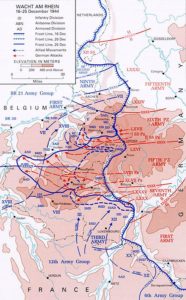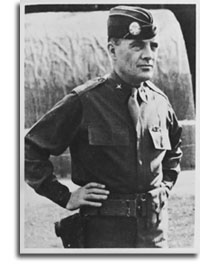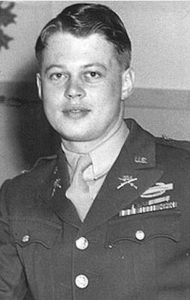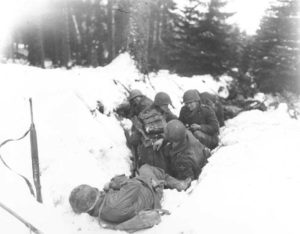Throughout this project, we have had the opportunity to interview many soldiers telling their stories. One of those stories came from Bob Freesen captured by our cast member and friend, Flo Plana.
Watching Flo interact with veterans, I am always struck with how quickly and easily he connects with each one of their stories. Flo knows the history of this era so well that he speaks with veterans in their language. In this clip, he instantly grasps the significance of Bob Freesen joining his unit in January 1945, the Battle of the Bulge. My understanding of this battle is basic and almost entirely informed by movies I have watched. With this being the 75th anniversary of that battle, I decided it was time to go deeper in honor of those that served like Bob Freesen.
 I knew that in the wake of the successful landing in Normandy, the Allies pushed east liberating France. By December 1944, it was clear to the Allies that the tide of war was swinging in their favor. In a last-ditch offensive, Hitler attempted to split the Allied forces by pushing through the Ardennes to the English Channel, much like he had in 1940. I learned that the generals surrounding Hitler thought his plan was too risky and tried for weeks to propose a more measured and defensive response to the Allied advance. In the end, Hitler could not be discouraged. One German general, Field Marshal Model, believed the plan only had a 10% chance of succeeding.
I knew that in the wake of the successful landing in Normandy, the Allies pushed east liberating France. By December 1944, it was clear to the Allies that the tide of war was swinging in their favor. In a last-ditch offensive, Hitler attempted to split the Allied forces by pushing through the Ardennes to the English Channel, much like he had in 1940. I learned that the generals surrounding Hitler thought his plan was too risky and tried for weeks to propose a more measured and defensive response to the Allied advance. In the end, Hitler could not be discouraged. One German general, Field Marshal Model, believed the plan only had a 10% chance of succeeding.
History shows the generals were correct, and Hitler’s plan failed, further depleting the German resources and crippling several Panzer divisions. However, until recently, I did not understand the full scope of the battle. The Battle of the Bulge began on the early hours of December 16th with a two-hour barrage from 1,600 pieces of artillery along the 80-mile-long Allied line. The initial German advance was nearly 200,000 men and 1,000 tanks against the Allies. Most of the Allied forces were either battle-weary, exhausted troops which had fought all their way across France or new green recruits who had not seen battle. It would take the Allies until January 25th to push the Germans back to their assault began. Terrible weather conditions complicated the battle for both sides, with the average high temperature just 33.5 ° F and the average low 22.6° F. At the end of those six weeks, Allied casualties were from 75,000 to 80,000, and the Germans lost anywhere from 100,000 to 120,000 men.
Where the invasion of Normandy was a success and stands as a testament to brilliant logistics, the Battle of Bulge was a failure of logistics. Several writers point out that the Allies prevailed only because of the will and determination of the soldiers in the field. One of the best and most famous of these stands is the Siege of Bastogne. Over seven days, Brigadier General Anthony McAuliffe leading the 101st defended the surrounded city. They were outnumbered 5 to 1 until a portion of Patton’s Third Army reached Bastogne. Their bravery and exploits are legendary, earning them the title “The Battered Bastards of Bastogne.”
While researching this article, I learned that their grit and determination was just one of many, many stories from this infamous battle. There is the battle for Lanzerath, which takes place on the very first day of fighting. Lanzerath was a small town that lay along a vital road that the Germans needed to secure. On December 16th, a small intelligence and reconnaissance platoon of 18 men along with 4 artillery observers under the command of 20-year-old Lieutenant Lyle Bouck Jr.  faced a battalion of 500 German soldiers. For twenty hours, this small band of fighters held the Germans at bay before finally having to surrender. There was one US causality during the battle, whereas the Germans lost 92 men. At the time, Bouck believed he had failed. In reality, the delay caused by Lieutenant Bouck and his men slowed the German advance. What had taken 9 hours in 1940 took the Germans 36 hours in 1944. The Germans never compensated for this disruption to their attack plan, and the delay gave the Allies time to move reinforcements to the area.
faced a battalion of 500 German soldiers. For twenty hours, this small band of fighters held the Germans at bay before finally having to surrender. There was one US causality during the battle, whereas the Germans lost 92 men. At the time, Bouck believed he had failed. In reality, the delay caused by Lieutenant Bouck and his men slowed the German advance. What had taken 9 hours in 1940 took the Germans 36 hours in 1944. The Germans never compensated for this disruption to their attack plan, and the delay gave the Allies time to move reinforcements to the area.
Further north was the Battle of Elsenborn Ridge near Monschau and the northernmost point of the German offensive. The Americans’ entrenched artillery defended the ridge from the German assault. It was the only point along the Allied line where the Germans failed to advance. If the Germans had broken through, historians believe that Hilter’s plan would have succeeded: splitting the Allied forces and retaking the port at Antwerp.
These were just two of the many stories that I discovered. As I read one story, it led to another and another. There are so many stories of service and sacrifice that I feel as if I have barely scratched the surface. I would love to hear your recommendations for books or documentaries that explore this pivotal battle in the liberation of Europe, so please leave your comments below.


Thanks for a great story about a horrific battle. Alex Kershaw’s book, The Longest Winter, tells the extraordinary story of Lt. Bouck and his platoon, their fight to defend Lanzerath and their continued fight to survive the POW camps. They were the most decorated platoon of WWII. Kershaw’s interviews with the men and other Bulge survivors are incredible!
I will add that to my reading list. Thanks for the suggestion, and thanks for reading, Vera.